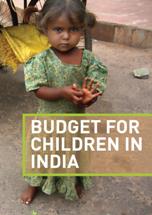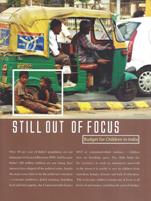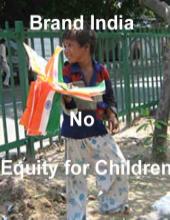 Menu
MenuThe budget is the most concrete expression of the government’s intention, policies, priorities, decisions and performance. At the national level or at the state level, the budget is essentially a political rather than a technical instrument. For HAQ, budget analysis fitted perfectly into its work of watching over and monitoring the state’s performance in all matters pertaining to the realisation of child rights. Such initiatives in budget analysis were already being undertaken in the country at state level with respect to Dalits, the tribal community and rural development etc. However the focus on children was missing from any such analysis.
The budget for children work (BfC) in India began in 2000 with a decadal analysis of the Union Budget by HAQ. The decade of the 1990s marked many changes for India and it’s children.
While India made some significant commitments towards ensuring children their basic rights, it also launched the era of liberal economic policies and globalisation. Both these events had an impact on children’s lives. It was therefore felt that a decadal analysis would produce a comprehensive picture of the government’s commitment towards children in terms of actual financial resource allocations.
Released in September 11, 2001, HAQ’s Budget for Children (BfC) analysis was the first endeavour of its kind in the country. The document established the need for such analyses and set the initial direction for developing a methodology to do this more effectively. Since then HAQ has been undertaking BfC analysis every year (See below to download reports).
Recognising the limitation of concentrating solely on the Union Budgets, HAQ decided to undertake BfC in the States as well in 2002.
The BfC is not a separate budget; it is an attempt to disaggregate from the overall budget, the allocations made specifically for programmes that benefit children. The analysis of BfC in India – both at the level of the Union government or a state government– is a rather complex exercise. It involves disaggregating from various heads of account in the overall Union or state budget to find out how changes in financial allocation impact the lives of children. Both the methodology and the analysis need to be refined and revised continuously in order to meet challenges that arise every year so that one can respond more effectively to the needs of children.
Even as we analyse allocations for children, HAQ recognises that what is needed is mainstreaming of children's concerns into all developmental and governance activities of the government.
This has been most succinctly recognised and articulated in South Africa by the President's Office over a decade ago:
"The concept of mainstreaming means that each government department incorporates children's issues into their respective portfolios. It calls upon each department to reflect its commitment to children, with corresponding budgetary allocation. With this approach, there is no single 'children's budget', rather, children's issues…(are supposed to)..inform every department's budget".
President's Office-Office on the Status of the Child.1999.National Programme of Action 2000 and Beyond: An Assesment of the NPA and the Way Forward, Pretoria:Government of South Africa
In October 2005, the Government of India declared its intention to undertake BfC at the Central as well as state level. Child budgeting has since been included in the government’s National Plan of Action for Children (2005).
Budget for Children Article by Enakshi Ganguly, From Human Rights and Public Finance

|

|

|

|
| Budget for Children in India 2008-09 to 2013-14: A Summary | Still Out of Focus Budget for Children in India | Brand India: No Equity for Children | India’s Children Budget for Children Handout 2001 |